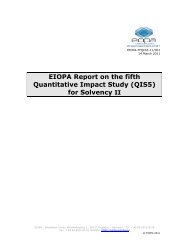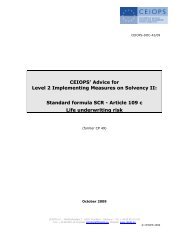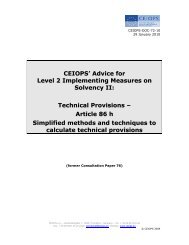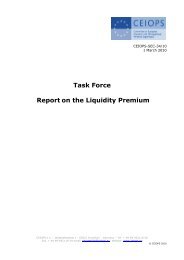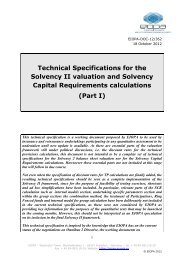Answers to the European Commission on the ... - Eiopa - Europa
Answers to the European Commission on the ... - Eiopa - Europa
Answers to the European Commission on the ... - Eiopa - Europa
You also want an ePaper? Increase the reach of your titles
YUMPU automatically turns print PDFs into web optimized ePapers that Google loves.
<str<strong>on</strong>g>the</str<strong>on</strong>g> rules <strong>on</strong> <str<strong>on</strong>g>the</str<strong>on</strong>g> calculati<strong>on</strong> of <str<strong>on</strong>g>the</str<strong>on</strong>g> technical provisi<strong>on</strong>s <str<strong>on</strong>g>to</str<strong>on</strong>g> be developed<br />
as part of <str<strong>on</strong>g>the</str<strong>on</strong>g> future solvency framework (cf. CfA 7 – technical<br />
provisi<strong>on</strong>s in life insurance).<br />
B.6 If <str<strong>on</strong>g>the</str<strong>on</strong>g> technical provisi<strong>on</strong> is defined as a sum of <str<strong>on</strong>g>the</str<strong>on</strong>g> best estimate and a<br />
risk margin that reflects <str<strong>on</strong>g>the</str<strong>on</strong>g> volatility of <str<strong>on</strong>g>the</str<strong>on</strong>g> claims, it may also be<br />
possible <str<strong>on</strong>g>to</str<strong>on</strong>g> choose <str<strong>on</strong>g>the</str<strong>on</strong>g> best estimate as <str<strong>on</strong>g>the</str<strong>on</strong>g> volume measure. However,<br />
such a choice would need <str<strong>on</strong>g>to</str<strong>on</strong>g> be reflected in <str<strong>on</strong>g>the</str<strong>on</strong>g> degree of volatility that<br />
is taken in<str<strong>on</strong>g>to</str<strong>on</strong>g> account in <str<strong>on</strong>g>the</str<strong>on</strong>g> definiti<strong>on</strong> of <str<strong>on</strong>g>the</str<strong>on</strong>g> coefficient applicable <str<strong>on</strong>g>to</str<strong>on</strong>g> <str<strong>on</strong>g>the</str<strong>on</strong>g><br />
volume measure.<br />
- Lapse risk<br />
B.7 With regards <str<strong>on</strong>g>to</str<strong>on</strong>g> lapse risk <str<strong>on</strong>g>the</str<strong>on</strong>g>re are two primary effects of<br />
unanticipated lapse rates. The first involves <str<strong>on</strong>g>the</str<strong>on</strong>g> payment of surrender<br />
or terminati<strong>on</strong> values. The relati<strong>on</strong>ship of <str<strong>on</strong>g>the</str<strong>on</strong>g> amount of a surrender<br />
payment <str<strong>on</strong>g>to</str<strong>on</strong>g> <str<strong>on</strong>g>the</str<strong>on</strong>g> value of <str<strong>on</strong>g>the</str<strong>on</strong>g> liability being held in respect of a particular<br />
policy is of great importance. When a policy lapses <str<strong>on</strong>g>the</str<strong>on</strong>g> insurer pays <str<strong>on</strong>g>the</str<strong>on</strong>g><br />
surrender value and 'receives' <str<strong>on</strong>g>the</str<strong>on</strong>g> actuarial reserve that is released by<br />
<str<strong>on</strong>g>the</str<strong>on</strong>g> policy’s terminati<strong>on</strong>. If surrender values are lower than policy<br />
reserves, <str<strong>on</strong>g>the</str<strong>on</strong>g> insurer is at risk from lapse rates that are lower than<br />
expected, particularly if high lapse rates were anticipated in <str<strong>on</strong>g>the</str<strong>on</strong>g> pricing<br />
of a product. The case that surrender values exceed policy reserves<br />
results in higher lapse rates being unfavourable <str<strong>on</strong>g>to</str<strong>on</strong>g> <str<strong>on</strong>g>the</str<strong>on</strong>g> insurer.<br />
However, if according <str<strong>on</strong>g>to</str<strong>on</strong>g> IAIS, technical provisi<strong>on</strong>s must not be lower<br />
than surrender values, <str<strong>on</strong>g>the</str<strong>on</strong>g>re is no risk in an increase in lapse rates.<br />
B.8 The sec<strong>on</strong>d primary effect of unanticipated lapse rates is that <str<strong>on</strong>g>the</str<strong>on</strong>g><br />
insurer may not realise <str<strong>on</strong>g>the</str<strong>on</strong>g> expected recovery from future premiums of<br />
initial policy acquisiti<strong>on</strong> expenses. These acquisiti<strong>on</strong> expenses may be<br />
recognized implicitly in financial statements through <str<strong>on</strong>g>the</str<strong>on</strong>g> use of<br />
modified net level premium valuati<strong>on</strong> methods. These implicit methods<br />
currently do not include any provisi<strong>on</strong> for un-favourable variati<strong>on</strong>s in<br />
lapse rates. Under a best estimate plus a risk margin valuati<strong>on</strong><br />
approach <str<strong>on</strong>g>the</str<strong>on</strong>g>se unfavourable variati<strong>on</strong>s should be partly included in <str<strong>on</strong>g>the</str<strong>on</strong>g><br />
risk margin.<br />
B.9 A capital requirement with respect <str<strong>on</strong>g>to</str<strong>on</strong>g> <str<strong>on</strong>g>the</str<strong>on</strong>g> first type of lapse risk (cf.<br />
B. 7) requires <str<strong>on</strong>g>the</str<strong>on</strong>g> divisi<strong>on</strong> of an insurance company’s policies in<str<strong>on</strong>g>to</str<strong>on</strong>g> two<br />
classes: first those policies for which <str<strong>on</strong>g>the</str<strong>on</strong>g> technical provisi<strong>on</strong>s TP are<br />
greater than surrender values S, and sec<strong>on</strong>d those policies for which S<br />
> TP. This suggests choosing S–TP and TP-S, as volume measures for<br />
<str<strong>on</strong>g>the</str<strong>on</strong>g> first type of lapse risk.<br />
B.10 For <str<strong>on</strong>g>the</str<strong>on</strong>g> sec<strong>on</strong>d type of lapse risk (cf. B.8), <str<strong>on</strong>g>the</str<strong>on</strong>g> technical provisi<strong>on</strong><br />
seems <str<strong>on</strong>g>to</str<strong>on</strong>g> be <str<strong>on</strong>g>the</str<strong>on</strong>g> appropriate volume measure. Within a best estimate<br />
plus a risk margin valuati<strong>on</strong> approach <str<strong>on</strong>g>the</str<strong>on</strong>g> technical provisi<strong>on</strong> will need<br />
<str<strong>on</strong>g>to</str<strong>on</strong>g> include a provisi<strong>on</strong> for <str<strong>on</strong>g>the</str<strong>on</strong>g> impact of unfavourable variati<strong>on</strong>s in lapse<br />
rates <strong>on</strong> <str<strong>on</strong>g>the</str<strong>on</strong>g> expected recovery of <str<strong>on</strong>g>the</str<strong>on</strong>g> acquisiti<strong>on</strong> expenses.<br />
- Expense risk<br />
B.11 A detailed understanding of <str<strong>on</strong>g>the</str<strong>on</strong>g> insurer’s expense structure and<br />
expense drivers is a key element when determining <str<strong>on</strong>g>the</str<strong>on</strong>g> expense risk.<br />
237






